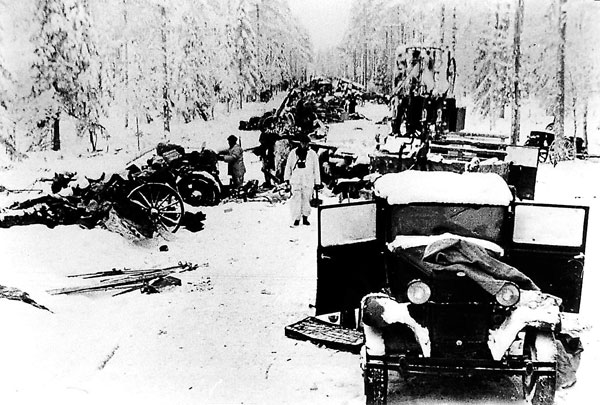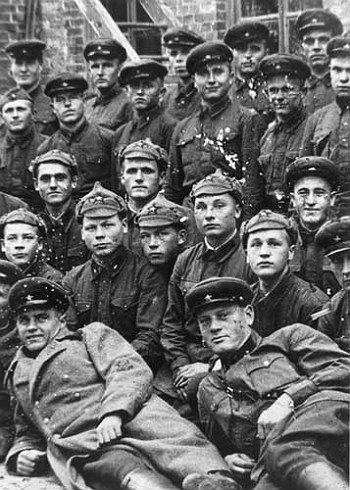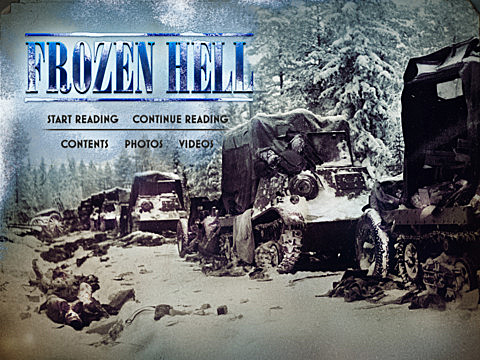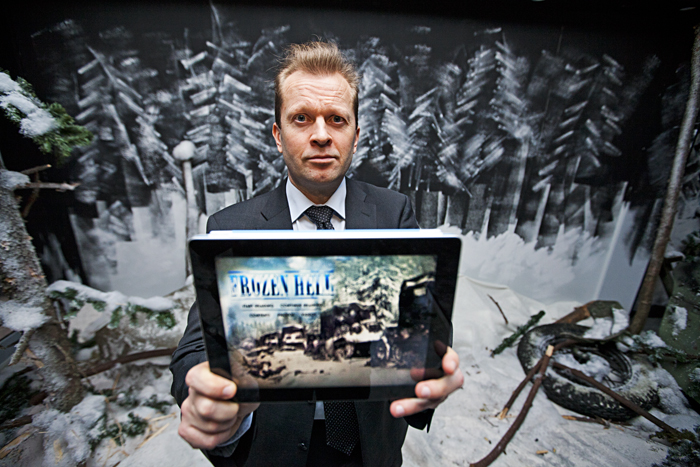Frozen Hell – The Legend and the Tragedy of Raate Road by Mika Kulju – the first book in English that covers the Battle of Raate Road in real detail
If you’re interested in the Winter War that was fought between the Soviet Union and Finland starting in late November 1939, then Frozen Hell – The Legend and the Tragedy of Raate Road is truly irresistible. And I say this as someone who has (with not much exaggeration) almost every book, in or out of print, written in English and available on this now little-known (outside of Finland) War. OK, I loved this book from the first chapter and I’ll get to that. First though, I’m going to clear up a question I initially had about the book’s title, then provide a bit of background on the subject of this book (the Battle of Raate Road), get into the multi-media nature of the book and finally review the content and my overall impressions of the book.
To start with, the title.
An earlier and well-known book on the Winter War by William Trotter is also titled “A Frozen Hell: The Russo-Finnish Winter War of 1939-1940”. Trotter’s book covers the Winter War in its entirety and should not be confused with this book by Mika Kulju, whose full title is “Frozen Hell – The Legend and the Tragedy of Raate Road” and whose subject is solely the Battle of Raate Road. The book is based on a Finnish-language best-seller, “Raatteen Tie: Talvisodan Pohjoinen Sankaritarina”, first published in 2007 (ISBN 978-951-20-7218-7 in case you’re interested). It’s also the first detailed coverage of this famous battle in English and for that alone I would recommend it – but there are other reasons I enjoyed this book besides the subject matter.
What was the Battle of Raate Road?
You may be forgiven for asking this question if you are not familiar with the Winter War, but if you are at all familiar, you will know that this was a part of the battle of Suomussalmi-Raate – which has gone down in military history as a classic encounter between forces of dramatically differing strength and composition, with the smaller Finnish forces inflicting an overwhelming defeat on the invading Red Army. Here begins the history lesson for non-Finns and for those with little or no knowledge of this battle – serving as a prelude to the review of the actual book.

Raate Road – the Spoils of War
Briefly, on the start of the Winter War on November 30, 1939, the Red Army committed two Divisions (the 163rd and the 44th) with orders to advance towards the village of Suomussalmi and then onwards to the city of Oulu, effectively cutting Finland in half at the waist. The area in question was a rugged wilderness with many lakes, wild forests and very few roads. In fact, there were only two narrow roads leading to Suomussalmi from the frontier: the northern Juntusranta Road (down which came the 163rd Division) and the southern Raate Road (down which came the 44th Division). This attack took the Finnish military command by surprise and was completely unexpected – as a result the sector had only one Finnish battalion (Er.P 15), which was in place near Raate, outside Suomussalmi. Suomussalmi was taken by the Soviet 163rd Division with little resistance on December 7, but the Finns destroyed the village before this, denying the Soviets shelter and then withdrawing their rather limited forces (2 Infantry Companies) to the opposite shore of the lakes Niskanselkä and Haukiperä. The first extensive fighting started on December 8, when Soviet forces began to attack across the frozen lakes to the west. Their attempts failed completely. A second Soviet force attacked to the northwest towards Puolanka – a position defended by a second Finnish battalion, Er.P 16, that had just arrived. This attack also failed.
On December 9, the defenders were reinforced with a newly established regiment (JR 27). Colonel Hjalmar Siilasvuo was given the overall command of the Finnish forces and he began moves to recapture Suomussalmi. The Finnish main forces advanced on Suomussalmi, but failed to take the village, suffering serious losses in the attack. The Finns then cut the northern supply route of the 163rd on 13 December. The 163rd was now nearly surrounded with the situation worsening as they suffered major casualties. On 20 December the 163rd’s commander, Andrei Zelentsov, asked permission to retreat from Suomussalmi. Zelentsov’s concerns were not understood at Red Army headquarters and the Soviet 44th Division was ordered to reinforce the 163rd Division troops. On December 24, the 163rd Division again counterattacked, but failed to break through the surrounding Finnish forces. Reinforced with two new regiments (JR 64 and JR 65), the Finns again attacked on December 27. This time, they took the village, and the Soviets retreated in panic, fleeing over the frozen lakes that surrounded Suomussalmi.

Ukrainian soldiers of the Red Army’s 44th Division
During this time, the Soviet 44th Division (mostly composed of Ukrainians) had advanced from the east towards Suomussalmi and was now entrenched on the road between Suomussalmi and Raate – on the Raate Road near Haukila, 12kms from Suomussalmi. Colonel Siilasvuo received orders to now destroy the Soviet 44th Division and the decisive battle began on January 5, 1940. Over January 5th and 6th the Finns attacked, breaking the Soviet forces up into smaller units and establishing several blocking positions between them. Over January 6, heavy fighting occurred all along the Raate Road as the Finns continued to break up the enemy forces into ever smaller chunks. The Soviets attempted to overrun Finnish roadblocks with armor, losing numerous tanks in frontal attacks, but were unsuccessful. Finally, at 21:30 on the 6th, the 44th Division commander, Vinogradov, ordered his division to retreat back to the Soviet border.
The despairing remnants of the Soviet 44th Division attempted to escape but were largely blocked by Finnish units. Many of these soldiers froze to death as they were without proper winter clothing or food. By noon on January 7 all Soviet resistance was suppressed. The mopping-up went on for two days, during which the Finns rounded up hundreds of starving, frozen Ukrainians and captured huge amounts of military equipment. Remnants of the 44th Division managed to escape the blockade and reached the border in several small groups. The Soviet commander, Vinogradov, and two of his senior officers, Volkov and Pahomov, fled in the middle of crucial battles, reached the Soviet lines four days later and were court-martialled, found guilty and sentenced to death; the executions were carried out on the spot. After the Winter War was over, the Finns returned their prisoners of war – the Soviet secret service (the NKVD) executed them all in the summer of 1940.The Battles of Suomussalmi and Raate Road were a double operation which provide a classic example of what well-led troops and innovative tactics can do against a much larger and much better armed and equipped adversary – and even when heavily out-numbered. Raate Road in particular resulted in the complete destruction both of units of the 163rd that had survived Suomussalmi as well as the entire Soviet 44th Division, some 14,000 Soviet troops in total. The Finnish units lost only 400 men. In addition, the Finnish troops captured dozens of tanks, artillery pieces, anti-tank guns, hundreds of trucks, almost 2,000 horses, thousands of rifles, and much-needed ammunition and medical supplies. The Battle gave a decisive boost to Finnish morale and generated favorable press reports and photos around the world.
And now, “Frozen Hell – The Legend and the Tragedy of Raate Road” itself….
First, let me say that I am by preference a buyer of printed books rather than e-books. However, after reading this book I was impressed (to say the least) and could well be persuaded to convert. As a multi-media book, this is pretty impressive. The original Finnish book that this is based on was a best-seller in Finland and the text has been translated into English directly from the contents of the original –it’s a good translation and the content is not at all dry – unlike many military histories, the author brings the subject to life – and the visual content really does enhance this experience. It’s also obvious that a great deal of thought went into converting this book into an e-book application. Not only are there numerous (high-resolution) photos (over 70 original photographs in all), there is also 30 minutes of video-clip material (sub-titled in English) of the Battle recovered from historic film in the Finnish film archives – and this film content has not been seen since it was first recorded in 1940. The film and the photos really help to bring the subject to life in a way that is not possible with paper-based books and the design and layout are exceptionally good.

Frozen Hell by Mika Kulju
The visual content also includes colour maps describing the course of the fighting in real detail, a step-by-step account of the fighting over the course of the battle, a “Military Power Meter” indicating the relative fighting strengths of the adversaries as the battle progressed and as you progress through the book and a Thermometer indicating the day-by-day temperatures of the “Frozen Hell” that the soldiers were forced to withstand throughout the Battle. The Thermometer really does illustrate the extreme (and for the soldiers of the Red Army, unbearable) cold that the soldiers on both sides had to endure – and had to fight in. It’s all this visual material that really make the book impressive – it really helps you visualize the conditions that the soldiers fought in and experienced – and if you’ve ever experienced the sort of cold conditions for yourself that the Battle was fought in, the visual material really brings home what it must have been like – far more so than mere text alone.
Navigation through the book was straightforward (even for me, and this was the first Apple App I have bought and read) and I liked the design and layout. Apart from the appeal of the subject matter (it’s the first detailed coverage of this famous battle in English – and that alone makes it worth buying for anyone interested in the Winter War). There’s a lot more visual content than in the original paper version of the book and this makes the complexities of the ongoing battle a lot easier to follow and to understand. Perhaps the biggest challenge facing the non-Finnish reader is grappling with the Finnish place names but with the maps to help, this becomes straightforward. Overall, I found the book to be well-written and the videos, photos and maps illustrate and enhance the text far more so than in a printed book. Personally, I was highly impressed by this book – the author, the graphic designers and the publishers (Gummerus) have done a marvelous job. After reading this book, I would very highly recommend it to anyone with an interest in the Winter War or for anyone interested in a very readable (and viewable) military history. It’s a whole new approach to creating a great “end user experience” for the reader.
My recommendation: Buy it, it’s great!
Just make sure you have an iPad though, as it is an iPad application rather than an iBook (OK, technical ignorance confession time – not being familiar with Apple technology, I was under the initial misapprehension that I could download this app onto my other half’s iPhone and read it there as an iBook. Ahem! Mistake. Took me a while to work through to the fact that I really needed an iPad to read this. And that’s a whole other story….. but once I worked through all of that, reading the book was great!
Here is a link to the publishers website listing Frozen Hell. You can buy the App via the Apple iStore.
And lastly, the Author

Author Miku Kulju
Finnish historian and non-fiction author Mika Kulju has written numerous works on Finland in the Second World War. The best known of these is his bestseller Raatteen tie (Gummerus 2007, 2009), now published in English as an e-book application for the iPad as Frozen Hell – The Legend and the Tragedy of Raate Road. “For the first time I have the chance to attract readers outside the small (Finnish) domestic market. That is why I wrote my e-book in English and why I selected one of the most legendary battles in military history as my subject,” Mika Kulju comments.
Born in 1969, Kulju graduated from the University of Oulu with a degree in Finnish and Scandinavian history. During his time at school and university, he was active in sports, meeting with varying degrees of success at cross-country skiing, athletics, orienteering and football. Following graduation and army service, Kulju worked as a librarian, a dock worker, in a nuclear power plant and as a history teacher. He started working as a freelance sports journalist in 1995 and has been writing for a living ever since.
Since then Kulju has worked on more than ten book project, either as a writer, journalist or as a publishing editor. His books are primarily about the business world and the history of the sport. He regards writing as a hobby which has evolved over the years into a very interesting job.
And just as a postscript, here is a Finnish Defence Forces newsreel clip from the Battle of Raate Road back at the time.
 Copyright secured by Digiprove © 2013 Alternative Finland
Copyright secured by Digiprove © 2013 Alternative Finland



6 Responses to Frozen Hell by Mika Kulju – (the Battle of Raate Road)